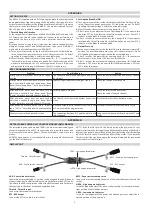
THE FLIGHT
Flying experience
This manual is only focusing on the points of the technique of flying that are important for the Papil
-
lon BODYGUARD 7. It cannot and should not replace a profound flight training in an approved flying
school! Without flight training and according experience paragliding is life-endangering!
The Launch
The 5-point pre-launch check must be performed before each flight. It is helpful to have the
check conducted additionally by a second pilot (partner check).
1. PILOT: All buckles, straps and clips of the harness closed? Leg straps closed? Carabiner
untwisted and closed properly? Helmet on? Radio on?
2. LINES: Lines free? A–lines on top? Risers untwisted? Speed system attached and untwisted?
Control lines free and not twisted?
3. CANOPY: Laid out in an arch? All chambers open?
4. WIND: From the right direction? Is the wind speed right?
5. AIRSPACE: Free on all sides?
The paraglider is laid out symmetrically in an arch, so that the canopy behind you can fill evenly
from the centre. The center of the Papillon BODYGUARD 7 is marked on the leading edge.
You launch the wing by a metered pull on the front risers with your arms stretched back and down
and running against the wind.
NOTE:
Unlike other gliders, it is not necessary to inflate the Papillon
BODYGUARD 7 with aggressive pulling or even fast running. That is
also true when there is little to zero wind. Measured pulling up is the
simplest and safest way to launch the Papillon BODYGUARD 7.
Once the canopy is above you, you let go of the risers and only keep the control lines in hand. Keep
running quickly, but not too fast, adapted to the wind situation. After a visual check of the canopy,
for which you possibly apply some brake pressure to stabilize the wing, the acceleration phase be
-
gins. With big, bold steps and still arms you reach take-off speed.
You take off the ground but remain ready to run in order to react to an unexpected drop. Only sit
down with sufficient ground clearance. The control lines are not released.










































